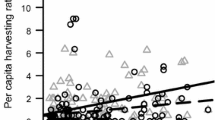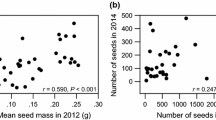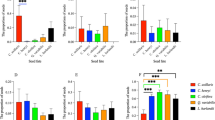Abstract
Scatter-hoarding animals are crucial in seed dispersal of nut-bearing plants. We used the holm oak Quercus ilex—wood mouse Apodemus sylvaticus mutualism as a model system to evaluate the relative importance of seed size and fat content on scatter-hoarders’ foraging decisions influencing oak dispersal and potential recruitment. We performed a field experiment in which we offered holm oak acorns with contrasting seed size (2 vs 5 g) and fat content (3 vs 11%). Moreover, to test if the strength of these seed trait effects was context-dependent, experimental acorns were placed in small fragments, where natural regeneration is scarce or absent, and forest habitats. In small fragments, rodents had to face increased intraspecific competition for acorns and reduced anti-predator cover during transportation. As a result, they became more selective to ensure rapid acquisition of most valuable food items but, in turn, transported seeds closer to avoid unaffordable predation risks. During harvesting and caching, larger acorns were prioritized and preferentially cached. Fat content only had a minor effect in harvesting preferences. In contrast, in forest sites, where rodent abundance was four times lower and understory cover was well-developed, rodents were not selective but provided enhanced dispersal services to oaks (caching rates were 75% higher). From the plants’ perspective, our results imply that the benefits of producing costly seeds are context-dependent. Seed traits modified harvesting and caching rates only when rodents were forced to forage more efficiently in response to increased intraspecific competition. However, when landscape traits limited cache protection strategies, a more selective foraging behavior by scatter-hoarders did not result in enhanced dispersal services. Overall, our result shows that successful dispersal of acorns depends on how specific traits modulate their value and how landscape properties affect rodents’ ability to safeguard them for later consumption.



Similar content being viewed by others
References
Alejano R, Vazquez-Pique J, Carevic F, Fernandez M (2011) Do ecological and silvicultural factors influence acorn mass in Holm Oak (southwestern Spain)? Agroforest Syst 83:25–39
Bates D, Maechler M, Bolker B, Walker S (2011) lme4: Linear mixed-effects models using Eigen and S4. R package version 1.0–5
Delignette-Muller ML, Pouillot R, Denis JB, Dutang C (2010) Fitdistrplus: help to fit of a parametric distribution to non-censored or censored data
Dey DC (2014) Sustaining oak forests in Eastern North America: regeneration and recruitment, the pillars of sustainability. For Sci 60:926–942
Díaz M (1992) Rodent seed predation in cereal crop areas of central Spain—Effects of physiognomy, food availability, and predation risk. Ecography 15:77–85
Díaz M, Torre I, Arrizabalaga A (2010) Relative roles of density and rainfall on the short-term regulation of Mediterranean wood mouse Apodemus sylvaticus populations. Acta Theriol 55:251–260
Duncan RS, Wenny DG, Spritzer MD, Whelan CJ (2002) Does human scent bias seed removal studies? Ecology 83:2630–2636
Fernández I, Gómez A, Moreno P et al (2004) Variabilidad de las características de las bellotas en el Valle de los Pedroches (Córdoba). Pastos y Ganadería Extensiva; XLIV Reunión Científica de la SEEP (ed. G.C.A. García Criado B., Vázquez de Aldana, B.R.., Zabalgogeazcoa I.), pp. 317–322. SEEP
Gallego D, Morán-López T, Torre I, Navarro-Castilla A, Barja I, Díaz M (2017) Context dependence of acorn handling by the Algerian mouse (Mus spretus). Acta Oecol 84:1–7
Galvan JV, Jorrin Novo JJ, Gómez-Cabrera A, Ariza D, García-Olmo J, Navarro Cerrillo RM (2012) Population variability based on the morphometry and chemical composition of the acorn in Holm oak (Quercus ilex subsp. ballota Desf. Samp.). Eur J For Res 131:893–904
Gálvez D, Kranstauber B, Kays RW, Jansen PA (2009) Scatter hoarding by the Central American agouti: a test of optimal cache spacing theory. Anim Behav 78:1327–1333
Gea-Izquierdo G, Cañellas I, Montero G (2006) Acorn production in Spanish holm oak woodlands. Invest. Agrar 15:339–354
Gelman A, Hill J (2007) Data analysis using regression and multilevel/hierarchical models. Cambridge University Press, Cambridge
Gómez JM (2004) Bigger is not always better: conflicting selective pressures on seed size in Quercus ilex. Evolution 58:71–80
Gómez JM, Puerta-Pinero C, Schupp EW (2008) Effectiveness of rodents as local seed dispersers of Holm oaks. Oecologia 155:529–537
Hochman V, Kotler BP (2007) Patch use, apprehension, and vigilance behavior of Nubian Ibex under perceived risk of predation. Behav Ecol 18:368–374
Jansen PA, Bongers F, Hemerik L (2004) Seed mass and mast seeding enhance dispersal by a neotropical scatter-hoarding rodent. Ecol Monogr 74:569–589
Lichti NI, Steele MA, Zhang H, Swihart RK (2014) Mast species composition alters seed fate in North American rodent-dispersed hardwoods. Ecology 95:1746–1758
Lichti NI, Steele MA, Swihart RK (2017) Seed fate and decision-making processes in scatter-hoarding rodents. Biol Rev 92:474–504
Lima SL, Valone TJ, Caraco T (1985) Foraging-efficiency-predation-risk trade-off in the grey squirrel. Anim Behav 33:155–165
Luczaj L, Adamczak A, Duda M (2014) Tannin content in acorns (Quercus spp.) from Poland. Dendrobiology 72:103–111
Martín D, Vázquez-Piqué J, Carevic F, Fernández M, Alejano R (2015) Trade-off between stem growth and acorn production in holm oak. Trees 29:825–834
Mitchell WA (1990) An optimal-control theory of diet selection—the effects of resource depletion and exploitative competition. Oikos 58:16–24
Moore JE, McEuen AB, Swihart RK, Contreras TA, Steele MA (2007) Determinants of seed removal distance by scatter-hoarding rodents in deciduous forests. Ecology 88:2529–2540
Morán-López T, Fernández M, Alonso CL, Flores-Rentería D, Valladares F, Diaz M (2015) Effects of forest fragmentation on the oak–rodent mutualism. Oikos 124:1482–1491
Morán-López T, Forner A, Flores-Rentería D, Díaz M, Valladares F (2016a) Some positive effects of the fragmentation of holm oak forests: attenuation of water stress and enhancement of acorn production. Forest Ecol Manag 370:22–30
Morán-López T, Wiegand T, Morales JM, Valladares F, Díaz M (2016b) Predicting forest management effects on oak–rodent mutualisms. Oikos 125:1445–1457
Muñoz A, Bonal R, Espelta JM (2012) Responses of a scatter-hoarding rodent to seed morphology: links between seed choices and seed variability. Anim Behav 84:1435–1442
Perea R, Gonzalez R, San Miguel A, Gil L (2011) Moonlight and shelter cause differential seed selection and removal by rodents. Anim Behav 82:717–723
Perea R, Miguel AS, Martinez-Jauregui M, Valbuena-Carabana M, Gil L (2012) Effects of seed quality and seed location on the removal of acorns and beechnuts. Eur J For Res 131:623–631
Pérez-Ramos IM, Urbieta IR, Maranon T, Zavala MA, Kobe RK (2008) Seed removal in two coexisting oak species: ecological consequences of seed size, plant cover and seed-drop timing. Oikos 117:1386–1396
Pesendorfer MB, Sillett TS, Koenig WD, Morrison SA (2016) Scatter-hoarding corvids as seed dispersers for oaks and pines: a review of a widely distributed mutualism and its utility to habitat restoration. Condor 118:215–237
Plumer M (2003) JAGS: A program for analysis of Bayesian graphical models using Gibbs sampling URL http://citeseer.ist.psu.edu/plummer03jags.html
Pons J, Pausas JG (2007) Rodent acorn selection in a Mediterranean oak landscape. Ecol Res 22:535–541
Prugh LR, Golde CG (2014) Does moonlight increase predation risk? Meta-analysis reveals divergent responses of nocturnal mammals to lunar cycles. J Anim Ecol 83:504–514
Puerta-Piñero C, Gómez JM, Schupp FW (2010) Spatial patterns of acorn dispersal by rodents: do acorn crop size and ungulate presence matter? Oikos 119:179–187
Pulido FJ, Díaz M (2005) Regeneration of a Mediterranean oak: a whole-cycle approach. EcoScience 12:92–102
Rosalino LM, Nobrega F, Santos-Reis M, Teixeira G, Rebelo R (2013) Acorn selection by the wood mouse Apodemus sylvaticus: a semi-controlled experiment in a mediterranean environment. Zool Sci 30(9):724–730
Sage RD, Koenig WD, McLaughlin BC (2011) Fitness consequences of seed size in the valley oak Quercus lobata N, e (Fagaceae). Ann For Sci 68(3):477–484
Santos T, Telleria JL (1997) Vertebrate predation on Holm Oak, Quercus ilex, acorns in a fragmented habitat: effects on seedling recruitment. For Ecol Manag 98(2):181–187
Santos T, Tellería JL (1998) Efectos de la fragmentación de los bosques sobre los vertebrados de las mesetas ibéricas. Organismo Autónomo “Parques Nacionales,” Madrid, Spain
Schupp EW, Jordano P, Gómez JM (2010) Seed dispersal effectiveness revisited: a conceptual review. New Phytol 188(2):333–353
Smit C, den Ouden J, Díaz M (2008) Facilitation of Quercus ilex recruitment by shrubs in Mediterranean open woodlands. J Veg Sci 19(2):193–200
Sunyer P, Muñoz A, Bonal R, Espelta JM (2013) The ecology of seed dispersal by small rodents: a role for predator and conspecific scents. Funct Ecol 27:1313–1321
Sunyer P, Espelta JM, Bonal R, Muñoz A (2014) Seeding phenology influences wood mouse seed choices: the overlooked role of timing in the foraging decisions by seed-dispersing rodents? Behav Ecol Sociobiol 68:1205–1213
Tecklin J, McCreary DD (1991) Acorn size as a factor in early seedling growth of blue oaks. In: Proceedings of the symposium on oak woodlands and hardwood rangeland management. October 31–November 2, 1990; Davis, California. Gen. Tech. Rep. PSW-GTR-126. Berkeley, CA: Pacific Southwest Research Station, Forest Service, U.S. Department of Agriculture; p. 48–53
Vander Wall SB (1990) Food Hoarding in Animals. University Chicago Press, Chicago
Vander Wall SB (2001) The evolutionary ecology of nut dispersal. Bot Rev 67:74–117
Wang B, Chen J (2008) Tannin concentration enhances seed caching by scatter-hoarding rodents: an experiment using artificial ‘seeds’. Acta Oecol 34:379–385
Wang B, Chen J (2009) Seed size, more than nutrient or tannin content, affects seed caching behavior of a common genus of Old World rodents. Ecology 90:3023–3032
Wang B, Chen J (2012) Effects of fat and protein levels on foraging preferences of tannin in scatter-hoarding rodents. PLoS ONE 7:e40640
Wang B, Yang XL (2014) Teasing apart the effects of seed size and energy content on rodent scatter-hoarding behavior. PLoS ONE 9:e111389
Wang B, Ye CX, Cannon CH, Chen J (2013) Dissecting the decision making process of scatter-hoarding rodents. Oikos 122:1027–1034
Xiao ZS, Jansen PA, Zhang ZB (2006a) Using seed-tagging methods for assessing post-dispersal seed fate in rodent-dispersed trees. Forest Ecol Manag 223:18–23
Xiao ZS, Wang YS, Harris M, Zhang ZB (2006b) Spatial and temporal variation of seed predation and removal of sympatric large-seeded species in relation to innate seed traits in a subtropical forest Southwest China. Forest Ecol Manag 222:46–54
Acknowledgements
We acknowledge Miguel Ángel Fernández, Xavier Rotllàn Puig, David López Quiroga and Dulce Flores Rentería for their invaluable technical support during fieldwork. Morán-López T. was beneficiary of a FPI grant (funded by the Spanish Government (BES-2011-048346) and a CONICET post-doctoral fellowship (funded by the Argentinian Government). This paper is a contribution to the Spanish-funded projects VULGLO (CGL2010–22180-C03–03), VERONICA (CGL2013-42271-P) and REMEDINAL 2 & 3 (CM S2009 AMB 1783; S2013/MAE-2719). NIR data were obtained using NIRS hardware and software provided by the NIR/MIR Spectroscopy Unit of the SCAI at the University of Cordoba, Campus de Excelencia CEIA3 (Spain).
Author information
Authors and Affiliations
Corresponding author
Additional information
Communicated by Elizabeth Pringle.
Appendices
Appendix 1: Model structure and priors for every response variable
Total foraging time
We modeled the total foraging time invested by mice as a Poisson process that depended on the fragmentation level (forest or fragment) and the number of acorns available. As acorns were in trees located within sites, we introduced tree nested in site as random factors.
Prior distributions—parameters at tree level
Hyper-prior distributions—parameters at site level
\(\sigma^{b0} \sim {\text{uniform}}\quad (0, 100)\)
\(y _{i,j,k}\) is the total foraging time of event i at tree j in site k. b0 is the mean time invested in non-fragmented sites, b1 depicts fragmentation effects. b2 represents the effect of the number of acorns available, which depends on forest fragmentation (α and δ). Each focal tree had a mean b0 and b2 effect (\(b0_{j,k} , b2_{j,k} )\), centered on the site where the tree is located \(\mu_{k}^{b0} ,\,\mu_{k}^{b2}\).
Handling—searching time
We modeled proportion of time invested in handling or searching as a binomial process that depended on the fragmentation level (forest or fragment) and the number of acorns available. As acorns were in trees located within sites, we introduced tree nested in site as random factors.
Prior distributions—parameters at tree level
Hyper-prior distributions—parameters at site level
\(\sigma^{b0} \sim {\text{uniform}} \quad(0, 100)\)
where \(y _{i,j,k}\) is either the searching or the handling time of event i at tree j in site k. Here, N is the total time of the foraging ith event. b0 is the mean time invested in non-fragmented sites, b1 depicts fragmentation effects. b2 represents the effect of the number of acorns available, which depends on forest fragmentation (α and δ). Each focal tree had a mean b0 and b2 effect \(\left( {b0_{j,k} , b2_{j,k} } \right)\), centered on the site where the tree is located \(\mu_{k}^{b0} ,\,\mu_{k}^{b2}\).
Vigilance time
We modeled time invested in vigilance as a zero-inflated binomial process that depended on the fragmentation level (forest or forest fragment) and the number of acorns available. As acorns were in trees located within sites, we introduced tree nested in site as random factors.
Prior distributions—parameters at tree level
Hyper-prior distributions—parameters at site level
\(y _{i,j,k}\) is whether the mouse invested time in vigilance or not during event i at tree j in site k, and \(r _{i,j,k}\) is the time invested in vigilance during event i at tree j in site k. The probability of investing time in vigilance (p1) depends on fragmentation level (forest or forest fragment). a0 is the mean time invested in non-fragmented sites and a1 depicts fragmentation effects. The proportion of time invested in vigilance (p2) depends on the number of acorns available. b2 represents the effect of the number of acorns available, which depends on forest fragmentation (α and δ). Each focal tree had a mean b0 and b2 effect \(\left( {a0_{j,k} , b1_{j,k} } \right)\), centered on the site where the tree is located \(\mu_{k}^{bo} ,\,\mu_{k}^{b1}\).
Depletion time
We modeled the depletion time (in seconds) as a Poisson process that depended on the fragmentation level (forest or fragment). As acorns were in trees located within sites, we introduced tree nested in site as random factors.
Prior distributions
Hyper-prior distributions—parameters at site level
\(y _{j,k}\) is the depletion time at tree j in site k. α is the mean time invested in non-fragmented sites and β depicts fragmentation effects. Each site had a mean α k .
Multiple choice model
We modeled the probability of an acorn being removed taking into account the number and types (fat content and size) of acorns available in each foraging event. This probability depended on acorns fat content and size. As acorns were in trees located within sites, we introduced tree nested in site as random factors.
Prior distributions—parameters at tree level
Hyper-prior distributions—parameters at site level
\(y _{i,j,k}\) is a binary variable that represents whether the acorn i at tree j in site k was removed (1), or not (0). N represents the number of acorns present in that foraging event at that tree. b1 is the probability of being removed given that the acorn is small and has low fat content, b2 is the effect of fat content, and b3 the effect of size. These effects depended on forest fragmentation (α and δ). Each focal tree had a mean b1, b2, and b3 effect (\(b1_{j,k} , b2_{j,k} ,b3_{j,k} )\), centered on the site where the tree was located \(\left(mu_{k}^{b1} ,\,\mu_{k}^{b2} ,\,\mu_{k}^{b3}\right)\).
First and last acorns removed
We modeled the probability of an acorn being removed first or last as a Bernoulli process that depended on their fat content and size. As acorns were in trees located within sites, we introduced tree nested in site as random factors.
Prior distributions—parameters at tree level
Hyper-prior distributions—parameters at site level
\(y _{i,j,k}\) is a binary variable that represents whether the acorn i at tree j in site k was removed first/last (1), or not (0). b1 is the probability of being removed first or last given that the acorn is small and has low fat content, b2 the effect of fat content, and b3 the effect of size. These effects depended on forest fragmentation (α and δ). Each focal tree had a mean b1, b2, and b3 effect (\(b1_{j,k} , b2_{j,k} ,b3_{j,k} )\), centered on the site where the tree was located \(\mu_{k}^{b1} ,\;\mu_{k}^{b2} ,\;\mu_{k}^{b3}\).
Dispersal distance
We modeled how far the mice transported the acorns with a normal distribution. We used a logarithmic transformation in other to meet normality. Dispersal distances depended on acorns fat content and size. As acorns were in trees located within sites, we introduced tree nested in site as random factors.
Prior distributions—parameters at tree level
Hyper-prior distributions—parameters at site level
\(y _{i,j,k}\) is the distance acorn i at tree j in site k was dispersed. b1 is the mean distance mice transport seeds given they are small and have low fat content, b2 the effect of fat content, and b3 the effect of size. These effects depended on forest fragmentation (α and δ). Each focal tree had a mean b1, b2, and b3 effect (\(b1_{j,k} , b2_{j,k} ,b3_{j,k} )\), centered on the site where the tree was located \(\mu_{k}^{b1} ,\;\mu_{k}^{b2} ,\;\mu_{k}^{b3}\).
Cached
We modeled if mice consumed or stored the acorns as a Bernoulli process that depended on acorn fat content and size. As acorns were in trees located within sites, we introduced tree nested in site as random factors.
Prior distributions—parameters at tree level
Hyper-prior distributions—parameters at site level
\(y _{i,j,k}\) is a binary variable that represents whether the acorn i at tree j in site k was cached (1), or not (0). b1 is the probability of being cached given that the acorn is small and has low fat content, b2 the effect of fat content and b3 the effect of size. These effects depended on forest fragmentation (α and δ). Each focal tree had a mean b1, b2, and b3 effect (\(b1_{j,k} , b2_{j,k} ,b3_{j,k} )\), centered on the site where the tree was located \(\mu_{k}^{b1} ,\,\mu_{k}^{b2} ,\,\mu_{k}^{b3} \,\).
Appendix 2
See Table 4.
Appendix 3 Posterior predictive checks of Bayesian models
Mouse foraging activity
Mouse foraging decisions
Rights and permissions
About this article
Cite this article
Morán-López, T., Valladares, F., Tiribelli, F. et al. Fragmentation modifies seed trait effects on scatter-hoarders’ foraging decisions. Plant Ecol 219, 325–342 (2018). https://doi.org/10.1007/s11258-018-0798-2
Received:
Accepted:
Published:
Issue Date:
DOI: https://doi.org/10.1007/s11258-018-0798-2












